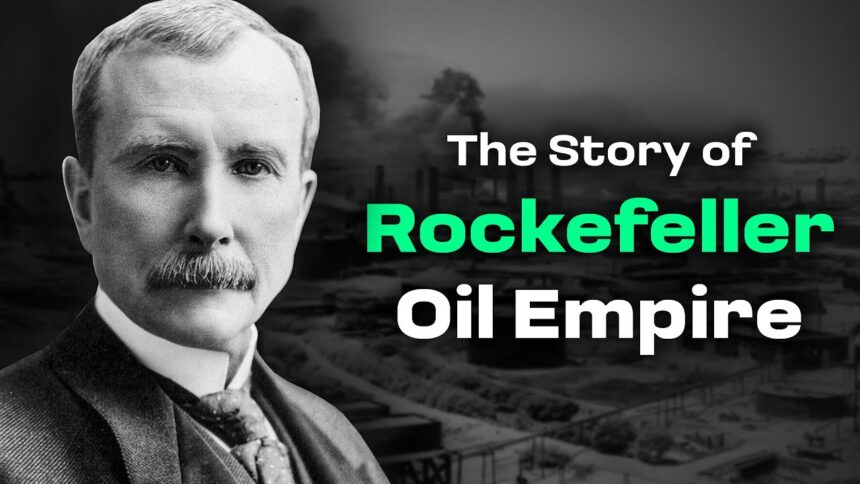In 1911, the court ruled that John Rockefeller’s Standard Oil was a monopoly, and the company had to split up. Despite this, it continued to control prices, and the “offspring” companies still lead the oil market today.
How Standard Oil became a monopoly
When Rockefeller and his associates began in the oil business in the 1860s, oil refining and logistics were still unorganized: the process was often costly and inefficient and the main petroleum product—kerosene—was of poor quality. Crude oil was transported by train in wooden barrels that were expensive and often leaked.
The journey required frequent stops at small refineries to fill barrels completely. To cover the logistics costs, manufacturers set high prices for their products.
This market inefficiency gave Standard Oil the chance to create a quality product that could be sold at the lowest possible price.
Standard Oil made several changes to the production process:
- They modified the refining process: kerosene was extracted from crude oil using fractional distillation and then it was purified by adding sulfuric acid.
- Almost 40% of the oil was previously considered waste and discarded after processing. Standard Oil turned these ‘wastes’ into new products—paraffin wax and gasoline—and sold them. Some of the gasoline was used to power their plants, which reduced coal costs.
- Each oil barrel cost $2.50. Standard Oil purchased forestland and started producing its own barrels at $1 each. Later, the company built pipelines to transport crude oil directly from production sites to refineries.
- Standard Oil convinced railway companies to give it a discount as a bulk client.
By affecting railway tariffs, Standard Oil deliberately drove competitors out of business. The company even bought barrels and tank cars to deny rivals access to transportation. Then, through front companies, it purchased oil factories and rigs from bankrupt competitors.
In 1870, Standard Oil had 4% of the US oil market that consisted of 250 independent producers. By 1874, its share had grown to 25%, and by 1880, it reached 85%.
Meanwhile, the price of oil dropped from 30 cents per gallon in 1869 to 8 cents in 1885: Rockefeller increased production and lowered prices, creating thousands of well-paid jobs. As a monopoly, Standard Oil raised prices and became the largest company in the world.
In 1882, Rockefeller formed the Standard Oil Trust—a group of 40 companies involved in oil extraction, refining, and distribution, with 14 of them fully owned by the trust. This allowed the Rockefeller Trust to control the refining industry.
At that time, the company employed 100,000 people, had 20,000 oil wells, and 5,000 tanker trucks.
The company evaded punishment under the antitrust law for 20 years
In 1890, the US government passed the Sherman Antitrust Act. From that point on, any contract, trust, or conspiracy intended to restrict trade and hinder competitors was deemed illegal.
The law was enacted for several reasons:
- Monopolies restricted trade, kept prices high, and reaped excessive profits.
- Competition among independent companies was needed to ensure fair prices, high-quality products, and reasonable profits.
Starting with Ohio in 1887, ten states filed 33 separate lawsuits against companies affiliated with Standard Oil Trust. In most cases, Standard Oil lost in court. But Rockefeller reorganized the trust, moved Standard Oil’s headquarters to New Jersey, and avoided court rulings to maintain his monopoly.
This outcome was possible due to Rockefeller’s skill in building relationships with the government. Standard Oil was a constant sponsor of both the Democratic and Republican parties.
The company bribed senators, disguising the payments as ‘funding’. The commissions investigating Standard Oil included Rockefeller’s agents who reported the situation to him and influenced decisions.
In 1890, Rockefeller managed to make a deal with politician Marcus Hanna to convince prosecutors not to open cases against the trust. Rockefeller and Hanna’s influence grew stronger in 1896 when William McKinley became the US president (Rockefeller had contributed $250,000 to his campaign).
Things started to change in 1901 when Theodore Roosevelt became president with an anti-monopoly stance and sued 45 monopolistic companies.
In 1895, Rockefeller began stepping away from management although he remained the largest shareholder. By 1897, day-to-day control had almost passed to the company’s vice president, John Archbold, who officially became the head of the company only in 1911.
Court case and breakup of Standard Oil
Since state lawsuits against Standard Oil led nowhere, journalists demanded federal lawsuits. Between 1902 and 1904, journalist Ida Tarbell wrote a series of 19 articles for McClure’s Magazine detailing the unfair practices Standard Oil used against competitors. Tarbell’s work helped the US government investigate Standard Oil’s case.
On November 18, 1906, the US Attorney General sued Standard Oil and its subsidiary companies under the trust. That same year, a lawsuit was filed against the company for violating antitrust laws.
The case lasted for over two years, with 444 witnesses called, and the complete report spanning 14,495 pages in 21 volumes.
In 1909, the US Federal Court ruled in favor of the government, ordered Standard Oil to dissolve and fined the company $29 million.
Standard Oil appealed to the Supreme Court. In May 1911, the judges upheld the federal court’s decision and gave Standard Oil six months to break itself up though they waived the fine. By then, the corporation’s market share had dropped to 64% (down from 88% twenty years earlier), but the company still remained a monopoly.
Standard Oil was split into 34 companies, mostly based on geography. Over time, the largest companies formed from Standard Oil became part of now more familiar brands: ExxonMobil, Shell, BP, Unilever, and others.
After the breakup, the government allowed Standard Oil shareholders to receive shares in all 34 companies. This meant that each company had shareholder-owners who were expected to compete against each other.
However, there were few incentives for competition. Shareholders acted together and continued to control oil pricing. Their activity after the breakup was largely unchecked, thanks to Rockefeller’s influence over US presidents William Taft and Thomas Wilson.
Early 20th-century changes
In the early 20th century, kerosene lamps were replaced by electricity but oil companies’ revenues did not decrease. Gasoline, a byproduct of oil refining previously considered useless, began to be used as automobile fuel. The development of the automotive industry made former trust members richer than ever.
Rockefeller’s wealth
In 1913, Rockefeller, who held a quarter stake in each of the 34 new companies, had a fortune valued at $900 million. He was the wealthiest man in the world at that time.










 /home/u448362301/domains/theexpotab.com/public_html/wp-content/themes/foxiz/templates/popup.php on line 167
/home/u448362301/domains/theexpotab.com/public_html/wp-content/themes/foxiz/templates/popup.php on line 167